Granite
plagioclase feldspar, and quartz | |
| Secondary | Differing amounts of muscovite, biotite, and hornblende-type amphiboles |
|---|---|
Granite (
Granite is typical of a larger family of granitic rocks, or granitoids, that are composed mostly of coarse-grained quartz and feldspars in varying proportions. These rocks are classified by the relative percentages of quartz, alkali feldspar, and plagioclase (the QAPF classification), with true granite representing granitic rocks rich in quartz and alkali feldspar. Most granitic rocks also contain mica or amphibole minerals, though a few (known as leucogranites) contain almost no dark minerals.

Granite is nearly always massive (lacking any internal structures), hard, and tough. These properties have made granite a widespread construction stone throughout human history.
Description

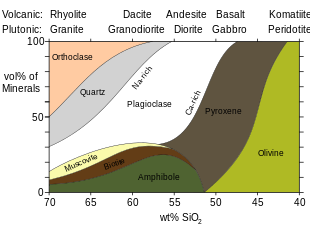
The word "granite" comes from the
The
Granitic rocks are classified according to the
True granites are further classified by the percentage of their total feldspar that is alkali feldspar. Granites whose feldspar is 65% to 90% alkali feldspar are syenogranites, while the feldspar in monzogranite is 35% to 65% alkali feldspar.[5][6] A granite containing both muscovite and biotite micas is called a binary or two-mica granite. Two-mica granites are typically high in potassium and low in plagioclase, and are usually S-type granites or A-type granites, as described below.[7][8]
Another aspect of granite classification is the ratios of metals that potentially form feldspars. Most granites have a composition such that almost all their aluminum and alkali metals (sodium and potassium) are combined as feldspar. This is the case when
Physical properties
The average density of granite is between 2.65 and 2.75 g/cm3 (165 and 172 lb/cu ft),[10] its compressive strength usually lies above 200 MPa (29,000 psi), and its viscosity near STP is 3–6·1020 Pa·s.[11]
The melting temperature of dry granite at ambient pressure is 1215–1260 °C (2219–2300 °F);[12] it is strongly reduced in the presence of water, down to 650 °C at a few hundred megapascals of pressure.[13]
Granite has poor primary
Chemical composition
A worldwide average of the chemical composition of granite, by weight percent, based on 2485 analyses:[14]
| SiO2 | 72.04% (silica) | |
| Al2O3 | 14.42% (alumina) | |
| K2O | 4.12% | |
| Na2O | 3.69% | |
| CaO | 1.82% | |
| FeO | 1.68% | |
| Fe2O3 | 1.22% | |
| MgO | 0.71% | |
| TiO2 | 0.30% | |
| P2O5 | 0.12% | |
| MnO | 0.05% |
The medium-grained equivalent of granite is microgranite.
Occurrence

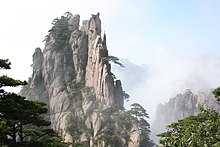

Granitic rock is widely distributed throughout the
Origin
Granite forms from silica-rich (
Early fractional crystallisation serves to reduce a melt in magnesium and chromium, and enrich the melt in iron, sodium, potassium, aluminum, and silicon.[21] Further fractionation reduces the content of iron, calcium, and titanium.[22] This is reflected in the high content of alkali feldspar and quartz in granite.
The presence of granitic rock in
Alphabet classification system
The composition and origin of any magma that differentiates into granite leave certain petrological evidence as to what the granite's parental rock was. The final texture and composition of a granite are generally distinctive as to its parental rock. For instance, a granite that is derived from partial melting of metasedimentary rocks may have more alkali feldspar, whereas a granite derived from partial melting of metaigneous rocks may be richer in plagioclase. It is on this basis that the modern "alphabet" classification schemes are based.
The letter-based Chappell & White classification system was proposed initially to divide granites into I-type (igneous source) granite and S-type (sedimentary sources).[25] Both types are produced by partial melting of crustal rocks, either metaigneous rocks or metasedimentary rocks.
I-type granites are characterized by a high content of sodium and calcium, and by a
S-type granites are sodium-poor and aluminum-rich. As a result, they contain micas such as biotite and muscovite instead of hornblende. Their strontium isotope ratio is typically greater than 0.708, suggesting a crustal origin. They also commonly contain xenoliths of metamorphosed sedimentary rock, and host tin ores. Their magmas are water-rich, and they readily solidify as the water outgasses from the magma at lower pressure, so they less commonly make it to the surface than magmas of I-type granites, which are thus more common as volcanic rock (rhyolite).[23] They are also orogenic but range from metaluminous to strongly peraluminous.[26]
Although both I- and S-type granites are orogenic, I-type granites are more common close to the convergent boundary than S-type. This is attributed to thicker crust further from the boundary, which results in more crustal melting.[23]
A-type granites show a peculiar mineralogy and geochemistry, with particularly high silicon and potassium at the expense of calcium and magnesium
M-type granite was later proposed to cover those granites that were clearly sourced from crystallized mafic magmas, generally sourced from the mantle.[33] Although the fractional crystallisation of basaltic melts can yield small amounts of granites, which are sometimes found in island arcs,[34] such granites must occur together with large amounts of basaltic rocks.[23]
H-type granites were suggested for hybrid granites, which were hypothesized to form by mixing between mafic and felsic from different sources, such as M-type and S-type.[35] However, the big difference in rheology between mafic and felsic magmas makes this process problematic in nature.[36]
Granitization
Granitization is an old, and largely discounted, hypothesis that granite is formed in place through extreme metasomatism. The idea behind granitization was that fluids would supposedly bring in elements such as potassium, and remove others, such as calcium, to transform a metamorphic rock into granite. This was supposed to occur across a migrating front. However, experimental work had established by the 1960s that granites were of igneous origin.[37] The mineralogical and chemical features of granite can be explained only by crystal-liquid phase relations, showing that there must have been at least enough melting to mobilize the magma.[38]
However, at sufficiently deep crustal levels, the distinction between metamorphism and crustal melting itself becomes vague. Conditions for crystallization of liquid magma are close enough to those of high-grade metamorphism that the rocks often bear a close resemblance.[39] Under these conditions, granitic melts can be produced in place through the partial melting of metamorphic rocks by extracting melt-mobile elements such as potassium and silicon into the melts but leaving others such as calcium and iron in granulite residues. This may be the origin of migmatites. A migmatite consists of dark, refractory rock (the melanosome) that is permeated by sheets and channels of light granitic rock (the leucosome). The leucosome is interpreted as partial melt of a parent rock that has begun to separate from the remaining solid residue (the melanosome).[40] If enough partial melt is produced, it will separate from the source rock, become more highly evolved through fractional crystallization during its ascent toward the surface, and become the magmatic parent of granitic rock. The residue of the source rock becomes a granulite.
The partial melting of solid rocks requires high temperatures and the addition of water or other volatiles which lower the
Ascent and emplacement
Granite magmas have a density of 2.4 Mg/m3, much less than the 2.8 Mg/m3 of high-grade metamorphic rock. This gives them tremendous buoyancy, so that ascent of the magma is inevitable once enough magma has accumulated. However, the question of precisely how such large quantities of magma are able to shove aside country rock to make room for themselves (the room problem) is still a matter of research.[43]
Two main mechanisms are thought to be important:
- Stokes diapir
- Fracture propagation
Of these two mechanisms, Stokes diapirism has been favoured for many years in the absence of a reasonable alternative. The basic idea is that magma will rise through the crust as a single mass through
Fracture propagation is the mechanism preferred by many geologists as it largely eliminates the major problems of moving a huge mass of magma through cold brittle crust. Magma rises instead in small channels along self-propagating dykes which form along new or pre-existing fracture or fault systems and networks of active shear zones.[45] As these narrow conduits open, the first magma to enter solidifies and provides a form of insulation for later magma.
These mechanisms can operate in tandem. For example, diapirs may continue to rise through the brittle upper crust through stoping, where the granite cracks the roof rocks, removing blocks of the overlying crust which then sink to the bottom of the diapir while the magma rises to take their place. This can occur as piecemeal stopping (stoping of small blocks of chamber roof), as cauldron subsidence (collapse of large blocks of chamber roof), or as roof foundering (complete collapse of the roof of a shallow magma chamber accompanied by a caldera eruption.) There is evidence for cauldron subsidence at the Mt. Ascutney intrusion in eastern Vermont.[46] Evidence for piecemeal stoping is found in intrusions that are rimmed with igneous breccia containing fragments of country rock.[43]
Assimilation is another mechanism of ascent, where the granite melts its way up into the crust and removes overlying material in this way. This is limited by the amount of thermal energy available, which must be replenished by crystallization of higher-melting minerals in the magma. Thus, the magma is melting crustal rock at its roof while simultaneously crystallizing at its base. This results in steady contamination with crustal material as the magma rises. This may not be evident in the major and minor element chemistry, since the minerals most likely to crystallize at the base of the chamber are the same ones that would crystallize anyway, but crustal assimilation is detectable in isotope ratios.[47] Heat loss to the country rock means that ascent by assimilation is limited to distance similar to the height of the magma chamber.[48]
Weathering
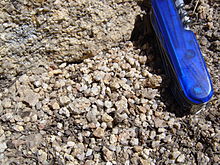
Climatic variations also influence the weathering rate of granites. For about two thousand years, the relief engravings on
Soil development on granite reflects the rock's high quartz content and dearth of available bases, with the base-poor status predisposing the soil to acidification and podzolization in cool humid climates as the weather-resistant quartz yields much sand.[52] Feldspars also weather slowly in cool climes, allowing sand to dominate the fine-earth fraction. In warm humid regions, the weathering of feldspar as described above is accelerated so as to allow a much higher proportion of clay with the Cecil soil series a prime example of the consequent Ultisol great soil group.[53]
Natural radiation
Granite is a natural source of
Many large granite plutons are sources for
Cellars and basements built into soils over granite can become a trap for radon gas,[citation needed] which is formed by the decay of uranium.[54] Radon gas poses significant health concerns and is the number two cause of lung cancer in the US behind smoking.[55]
Thorium occurs in all granites.[56] Conway granite has been noted for its relatively high thorium concentration of 56±6 ppm.[57]
There is some concern that some granite sold as countertops or building material may be hazardous to health.[58] Dan Steck of St. Johns University has stated[59] that approximately 5% of all granite is of concern, with the caveat that only a tiny percentage of the tens of thousands of granite slab types have been tested. Resources from national geological survey organizations are accessible online to assist in assessing the risk factors in granite country and design rules relating, in particular, to preventing accumulation of radon gas in enclosed basements and dwellings.
A study of granite countertops was done (initiated and paid for by the Marble Institute of America) in November 2008 by National Health and Engineering Inc. of USA. In this test, all of the 39 full-size granite slabs that were measured for the study showed radiation levels well below the European Union safety standards (section 4.1.1.1 of the National Health and Engineering study) and radon emission levels well below the average outdoor radon concentrations in the US.[60]
Industry
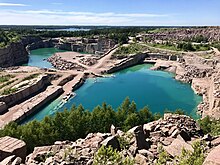
Granite and related
Major modern exporters of granite include China, India, Italy, Brazil, Canada, Germany, Sweden, Spain and the United States.[62]
Uses
Antiquity

The
The
Imperial Roman granite was quarried mainly in Egypt, and also in Turkey, and on the islands of
Modern
Sculpture and memorials

In some areas, granite is used for gravestones and memorials. Granite is a hard stone and requires skill to carve by hand. Until the early 18th century, in the Western world, granite could be carved only by hand tools with generally poor results.
A key breakthrough was the invention of steam-powered cutting and dressing tools by Alexander MacDonald of Aberdeen, inspired by seeing ancient Egyptian granite carvings. In 1832, the first polished tombstone of Aberdeen granite to be erected in an English cemetery was installed at Kensal Green Cemetery. It caused a sensation in the London monumental trade and for some years all polished granite ordered came from MacDonald's.[69] As a result of the work of sculptor William Leslie, and later Sidney Field, granite memorials became a major status symbol in Victorian Britain. The royal sarcophagus at Frogmore was probably the pinnacle of its work, and at 30 tons one of the largest. It was not until the 1880s that rival machinery and works could compete with the MacDonald works.
Modern methods of carving include using computer-controlled rotary bits and sandblasting over a rubber stencil. Leaving the letters, numbers, and emblems exposed and the remainder of the stone covered with rubber, the blaster can create virtually any kind of artwork or epitaph.
The stone known as "black granite" is usually gabbro, which has a completely different chemical composition.[70]
Buildings
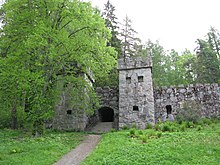
Granite has been extensively used as a dimension stone and as flooring tiles in public and commercial buildings and monuments. Aberdeen in Scotland, which is constructed principally from local granite, is known as "The Granite City". Because of its abundance in New England, granite was commonly used to build foundations for homes there. The Granite Railway, America's first railroad, was built to haul granite from the quarries in Quincy, Massachusetts, to the Neponset River in the 1820s.[71]
Engineering
Paving
Granite is used as a
Curling stones

Curling stones are traditionally fashioned of Ailsa Craig granite. The first stones were made in the 1750s, the original source being Ailsa Craig in Scotland. Because of the rarity of this granite, the best stones can cost as much as US$1,500. Between 60 and 70 percent of the stones used today are made from Ailsa Craig granite. Although the island is now a wildlife reserve, it is still quarried under license for Ailsa granite by Kays of Scotland for curling stones.[76]
Rock climbing
Granite is one of the rocks most prized by climbers, for its steepness, soundness, crack systems, and friction.[77] Well-known venues for granite climbing include the Yosemite Valley, the Bugaboos, the Mont Blanc massif (and peaks such as the Aiguille du Dru, the Mourne Mountains, the Adamello-Presanella Alps, the Aiguille du Midi and the Grandes Jorasses), the Bregaglia, Corsica, parts of the Karakoram (especially the Trango Towers), the Fitzroy Massif, Patagonia, Baffin Island, Ogawayama, the Cornish coast, the Cairngorms, Sugarloaf Mountain in Rio de Janeiro, Brazil, and the Stawamus Chief, British Columbia, Canada.
Gallery
-
Granite was used for (background)
-
Half Dome, Yosemite National Park, is actually a granite arête and is a popular rock climbing destination
-
Rixö red granite quarry in Lysekil, Sweden
-
Granite in Auyuittuq National Park on Baffin Island, Canada
-
Granite in Paarl, South Africa
-
The graves of Emperor Pedro I of Brazil (also King of Portugal as Pedro IV) and his two wives Maria Leopoldina (not pictured, facing his grave) and Amélie (left), in the Monument to the Independence of Brazil, are made of green granite. The walls as well as the floor are clad with the same material.[78]
See also
- Exfoliating granite – Granite skin peeling like an onion (desquamation) because of weathering
- Greisen – Highly altered granitic rock or pegmatite
- Hypersolvus – Type of granite, with a single feldspar
- List of rock types – List of rock types recognized by geologists
- Luxullianite – Rare type of granite
- Orbicular granite
- Quartz monzonite – Type of igneous rock
- Rapakivi granite – Type of igneous rock
- Subsolvus – Two feldspar granite
References
- Citations
- .
- ^ "Granitoids – Granite and the Related Rocks Granodiorite, Diorite and Tonalite". Geology.about.com. 2010-02-06. Retrieved 2010-05-09.
- ISBN 0-7167-2438-3.
- S2CID 28548230.
- ^ a b "Rock Classification Scheme - Vol 1 - Igneous" (PDF). British Geological Survey: Rock Classification Scheme. 1: 1–52. 1999.
- ^ ISBN 9780521880060.
- .
- JSTOR 24532555.
- ^ Harvey Blatt; Robert J. Tracy (1997). Petrology (2nd ed). New York: Freeman. p. 66. ISBN 0-7167-2438-3.|p=185
- ^ "Rock Types and Specific Gravities". EduMine. Archived from the original on 2017-08-31. Retrieved 2017-08-27.
- .
- ^ Larsen, Esper S. (1929). "The temperatures of magmas". American Mineralogist. 14: 81–94.
- .
- ^ Blatt and Tracy 1996, p.66
- The Open University. Retrieved 28 December 2021.
- ISBN 978-0-12-408133-8.
- ISBN 9788183564380.
- ISBN 0444421165. Retrieved 10 October 2020.
- ^ Philpotts & Ague 2009, pp. 15–16.
- .
- ^ Blatt & Tracy 1996, p. 128.
- ^ Blatt & Tracy 1996, p. 172.
- ^ a b c d e f Philpotts & Ague 2009, p. 378.
- S2CID 128993656.
- (PDF) from the original on Oct 22, 2022.
- ^ a b c Blatt & Tracy 1996, p. 185.
- ISBN 9781292021539.
- ^ Philpotts & Ague 2009, p. 148.
- ^ Blatt & Tracy 1996, pp. 203–206.
- S2CID 128541930.
- S2CID 128395509.
- S2CID 128878481.
- .
- .
- .
- ^ Philpotts & Ague 2009, pp. 104–105.
- ^ Philpotts & Ague 2009, p. 511.
- ISBN 0877353239.
- ^ McBirney 1984, pp. 379–380.
- ^ Philpotts & Ague 2009, p. 44.
- .
- .
- ^ a b Philpotts & Ague 2009, p. 80.
- S2CID 19470906.
- S2CID 129958999.
- ^ Blatt & Tracy 1996, pp. 21–22.
- ^ Philpotts & Ague 2009, pp. 347–350.
- S2CID 120776326.
- ^ "Granite [Weathering]". University College London. Archived from the original on 15 October 2014. Retrieved 10 July 2014.
- ^ "Hydrolysis". Geological Society of London. Retrieved 10 July 2014.
- ISBN 9781107376649.
- ^ "Land Use Impacts". Land Use Impacts on Soil Quality. Retrieved 23 March 2022.
- ^ "Cecil – North Carolina State Soil" (PDF). Soil Science Society of America. Retrieved 23 March 2022.
- ^ "Decay series of Uranium". Archived from the original on March 9, 2012. Retrieved 2008-10-19.
- ^ "Radon and Cancer: Questions and Answers". National Cancer Institute. Retrieved 2008-10-19.
- Shell Oil Company/American Petroleum Institute. Archived from the original(PDF) on 2008-05-27. Retrieved 2014-11-10.
- PMID 16591014.
- ^ "Granite Countertops and Radiation". United States Environmental Protection Agency. 4 May 2015. Retrieved 7 January 2020.
- ^ Steck, Daniel J. (2009). "Pre- and Post-Market Measurements of Gamma Radiation and Radon Emanation from a Large Sample of Decorative Granites" (PDF). Nineteenth International Radon Symposium. pp. 28–51.
- ^ Environmental Health and Engineering (2008). "Natural Stone Countertops and Radon" (PDF). Archived from the original on 3 November 2010. Retrieved 2023-02-20.
{{cite web}}: CS1 maint: unfit URL (link) - ISBN 978-0-470-08305-5.
- ISBN 978-81-907237-8-7.
- ^ James A. Harrell. "Decorative Stones in the Pre-Ottoman Islamic Buildings of Cairo, Egypt". Retrieved 2008-01-06.
- ^ "Egyptian Genius: Stoneworking for Eternity". Archived from the original on 2007-10-14. Retrieved 2008-01-06.
- ISBN 9788981641306.
- ^ "Seokguram Grotto [UNESCO World Heritage] (경주 석굴암)".
- JSTOR 3632277.
- ^ .
- ^ Friends of West Norwood Cemetery newsletter 71 Alexander MacDonald (1794–1860) – Stonemason,
- ^ "Gabbro". Geology.com. Retrieved 2022-01-25.
- ISBN 0342278657. Retrieved 3 December 2020.
- ^ Ewans, M.C. (1966). The Haytor Granite Tramway and Stover Canal. Newton Abbot: David & Charles.
- .
- ^ Chersicla, Rick (January–March 2017). "What Free Men Can Do: The Winter War, the Use of Delay, and Lessons for the 21st Century" (PDF). Infantry: 63. Retrieved 3 December 2020.
- ^ "Sydney Streets technical specifications". November 2020. Retrieved 25 January 2022.
- ^ Roach, John (October 27, 2004). "National Geographic News — Puffins Return to Scottish Island Famous for Curling Stones". National Geographic News. Archived from the original on November 2, 2004.
- ^ Green, Stewart. "3 Types of Rock for Climbing: Granite, Sandstone & Limestone: The Geology of Rock Climbing". Liveabout.dotcom. Dotdash. Retrieved 3 December 2020.
- ^ De Matteo, Giovanna (12 September 2020). "Leopoldina e Teresa Cristina: descubra o que aconteceu com as "mães do Brasil"" (in Portuguese). Retrieved 29 December 2022.
Further reading
- Blasik, Miroslava; Hanika, Bogdashka, eds. (2012). Granite: Occurrence, Mineralogy and Origin. Hauppauge, New York: Nova Science. ISBN 978-1-62081-566-3.
- ISBN 978-0-415-36435-5.
- Marmo, Vladimir (1971). Granite Petrology and the Granite Problem. Amsterdam, Netherlands: Elsevier Scientific. ISBN 978-0-444-40852-5.

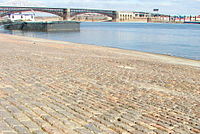

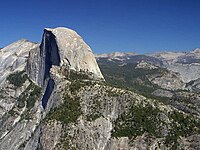



![The graves of Emperor Pedro I of Brazil (also King of Portugal as Pedro IV) and his two wives Maria Leopoldina (not pictured, facing his grave) and Amélie (left), in the Monument to the Independence of Brazil, are made of green granite. The walls as well as the floor are clad with the same material.[78]](http://upload.wikimedia.org/wikipedia/commons/thumb/b/b0/Olhares_sobre_o_Museu_do_Ipiranga_2017_041.jpg/200px-Olhares_sobre_o_Museu_do_Ipiranga_2017_041.jpg)